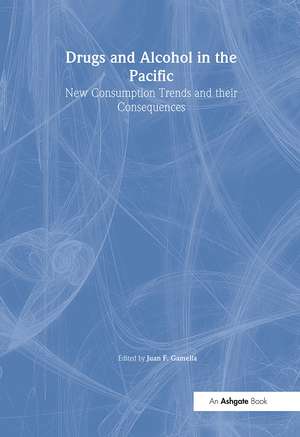Drugs and Alcohol in the Pacific: New Consumption Trends and their Consequences: The Pacific World: Lands, Peoples and History of the Pacific, 1500-1900
Editat de Juan F. Gamellaen Limba Engleză Hardback – 18 apr 2002
Din seria The Pacific World: Lands, Peoples and History of the Pacific, 1500-1900
- 9%
 Preț: 1281.93 lei
Preț: 1281.93 lei - 34%
 Preț: 1050.41 lei
Preț: 1050.41 lei - 9%
 Preț: 1281.76 lei
Preț: 1281.76 lei - 26%
 Preț: 1348.74 lei
Preț: 1348.74 lei - 33%
 Preț: 687.26 lei
Preț: 687.26 lei - 26%
 Preț: 1356.90 lei
Preț: 1356.90 lei - 26%
 Preț: 1014.74 lei
Preț: 1014.74 lei - 26%
 Preț: 1042.56 lei
Preț: 1042.56 lei - 25%
 Preț: 1248.30 lei
Preț: 1248.30 lei - 25%
 Preț: 1077.71 lei
Preț: 1077.71 lei - 26%
 Preț: 1209.56 lei
Preț: 1209.56 lei - 25%
 Preț: 1023.29 lei
Preț: 1023.29 lei - 26%
 Preț: 1042.56 lei
Preț: 1042.56 lei - 25%
 Preț: 1050.45 lei
Preț: 1050.45 lei - 25%
 Preț: 1613.83 lei
Preț: 1613.83 lei - 26%
 Preț: 1181.73 lei
Preț: 1181.73 lei
Preț: 352.95 lei
Preț vechi: 510.17 lei
-31% Nou
Puncte Express: 529
Preț estimativ în valută:
67.57€ • 69.49$ • 56.05£
67.57€ • 69.49$ • 56.05£
Comandă specială
Livrare economică 25 ianuarie-08 februarie
Doresc să fiu notificat când acest titlu va fi disponibil:
Se trimite...
Preluare comenzi: 021 569.72.76
Specificații
ISBN-13: 9780754601531
ISBN-10: 0754601536
Pagini: 444
Dimensiuni: 174 x 246 x 38 mm
Greutate: 0.45 kg
Ediția:1
Editura: Taylor & Francis
Colecția Routledge
Seria The Pacific World: Lands, Peoples and History of the Pacific, 1500-1900
Locul publicării:Oxford, United Kingdom
ISBN-10: 0754601536
Pagini: 444
Dimensiuni: 174 x 246 x 38 mm
Greutate: 0.45 kg
Ediția:1
Editura: Taylor & Francis
Colecția Routledge
Seria The Pacific World: Lands, Peoples and History of the Pacific, 1500-1900
Locul publicării:Oxford, United Kingdom
Cuprins
Contents: Preface; Introduction; The Indigenous Base: Antiquity of the use of new world hallucinogens, Richard Evans Schultes; Psychoactive substances of the South Seas: Betel, Kava and Pituri’, John Cawte; Peyotism, 1521-1891, J.S. Slotkin; Russian use of Amanita muscaria: a footnote to Wasson’s Soma, Ethel Dunn; Tobacco: The introduction of tobacco into Japan, Ernest M. Satow; Early prohibitions of tobacco in China and Manchuria, L. Carrington Goodrich; Tobacco, culture and health among American Indians: a historical review, Christina M. Pego, Robert F. Hill, Glenn W. Solomon, Robert M. Chisholm and Suzanne E. Ivey; Opium: Opium smoking in Ch’ing China, Jonathan Spence; Speculations on the nature and pattern of opium smoking, John C. Kramer; Opium in Java: a sinister friend, James R. Rush; The opium trade in Szechwan, 1881 to 1911, S.A.M. Adshead; Reform, nationalism and internationalism: the opium suppression movement in China and the Anglo-American influence, 1900-1908, Thomas D. Reins; Coca-Cocaine: Inca and colonial settlement, coca cultivation and endemic disease in the tropical forest, Daniel W. Gade; Coca and popular medicine in Peru: an historical analysis of attitudes, Joseph A. Gagliano; America’s first cocaine epidemic: What did we learn?, David F. Musto; Alcohol: Opening Pandora’s bottle: reconstructing Micronesians’ early contacts with alcoholic beverages, Mac Marshall and Leslie B. Marshall; Drinking, popular protest and governmental response in 17th- and 18th-century Latin America, John E. Kicza; Malhiot’s Journal: an ethnohistoric assessment of Chippewa alcohol behaviour in the early 19th century, Jack O. Waddell; Alcohol in Chinese poems: references to drunkenness, flushing and drinking, Julia Lee; A Battle not Man’s But God’s: origins of the American temperance crusade in the struggle for religious authority, Laura A. Schmidt; Index.
Recenzii
'The editor's introduction is useful in several ways, particularly as a good overview for non-experts... As to the specific articles, they seem to be well chosen to highlight the diversity of peoples, places, and practices in the Pacific.' Bulletin of the Pacific Circle
Descriere
From the arrival of Europeans in the Pacific in the 16th century, introduced psychoactive drugs have played a crucial role in the history of societies from China to Peru, and from Alaska to Australia. Tobacco, followed by opium, distilled alcohol, caffeinated drinks, as well as laboratory drugs such as morphine and cocaine, became standardized and massively produced commodities. These substances joined a local base of indigenous drugs and fermented beverages to create new traditions of consumption that characterized entire peoples and cultures. They were also tools of European domination, so crucial elements of cultural and economic change: opium in China, coca in the Andes, and tobacco and spirits in Oceania. New consumption and production patterns revealed important differences among cultures and polities of the region, and spawned social problems that, in turn, transformed collective representations of these substances. Some became powerful moral symbols that shaped influential social and political movements, such as the Temperance League in the U.S., and the anti-opium movement in China.
